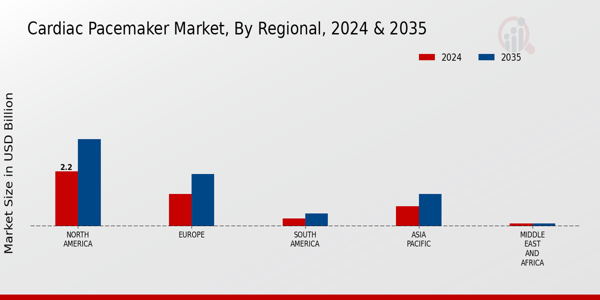Market Share
Cardiac Pacemaker Market Share Analysis
Remote monitoring and connectivity are major marketing priorities in cardiac pacemakers. Another type involves integrating wireless technologies with mobile health applications, allowing healthcare providers to monitor patients 'cardiac status remotely and set device settings optimally; if needed, the provider can intervene nearly instantly. Aware of the differences in patient profiles, companies design cardiac pacemakers to fit clinical needs. Designing tailored devices for different ages, comorbidities, and lifestyles supports effective treatment outcomes that maintain patient satisfaction. Investment in educational activities to teach medical personnel how to implant and program cardiac pacemakers. Such programs help to raise awareness, develop skills and promote the use of proven practices in cardiac rhythm management. Others are actively involved in patient education activities concerning cardiac pacemakers. These programs teach patients about the advantages, life adjustments and care of pacemaker devices. Higher compliance with treatment plans can lead to better health outcomes. Considering the financial considerations for patients, companies are coming up with affordability initiatives. This means pricing strategies, patient assistance programs and cooperation with insurance companies toward more accessible cardiac pacemakers to remove financial barriers to treatment.With cardiac devices so vital, companies put compliance with regulations and conformance to international quality standards at the top of their agendas. Complying with strict safety and efficacy standards earns the trust of healthcare professionals and patients. Some companies are integrating sustainability into their cardiac pacemaker programs. This means environmentally sound design, proper handling of waste products, and the reduction of any environmental impact from cardiovascular device production to the minimum extent possible. Personalized for the unique needs of pediatric patients are developing rapidly. Pediatric cardiac care is enhanced by smaller sizes, lower pacing thresholds and more advanced programming features for growing children.The firms have strengthened their supply chain robustness to secure cardiac pacemakers' consistent and uninterrupted delivery. This means spreading out manufacturing, guaranteeing a stable supply of raw materials and implementing risk management practices against crises. Innovation is pivotal. Advanced pacing therapies beyond traditional pacemaking are being researched by investing firms. This covers cardiac resynchronization therapy (CRT) and leadless pacing technologies, providing additional options to patients with difficult-to-treat heart problems.














Leave a Comment